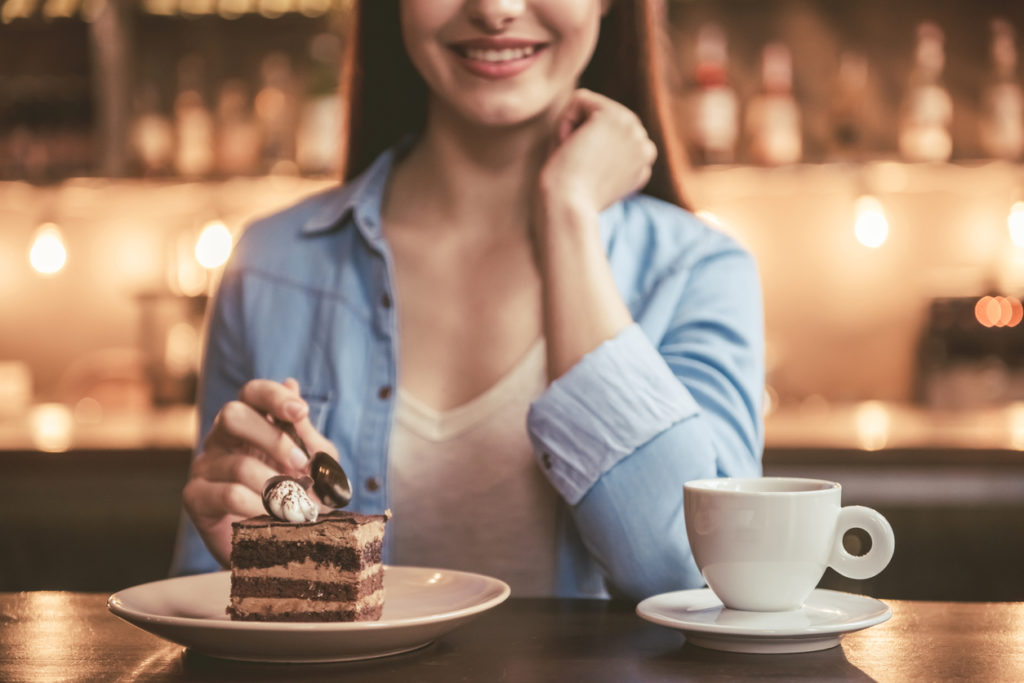Step 1: Stop eating with guilt
Your joyous path to slimness will involve learning that you can eat alone, at restaurants, parties, with family, with friends … anywhere, anyhow but never with guilt. Research published in Appetite confirmed that your weight loss is unlikely to be successful if you associate guilt with eating.This was confirmed by a particular study in which participants were asked whether they felt ‘guilt’ or ‘celebration’ with a forbidden food item (e.g. chocolate cake).
They examined if their attitude was related to perceived behavioural control, intentions to eat healthily and whether they were able to lose weight over an 18 month period (and short-term weight-loss in a subsample of participants with a weight-loss goal). Participants associating chocolate cake with guilt did not report more positive attitudes or stronger intentions to eat healthy than those associating chocolate cake with celebration. Instead, they reported lower levels of perceived behavioural control over eating and were less successful at maintaining their weight over an 18-month period. Weight-loss goal participants who associated chocolate cake with guilt were less successful at losing weight over a 3-month period compared to those associating chocolate cake with celebration.
This finding is similar to the ‘milkshake study’ mentioned previously that confirms that it’s our perception rather than an actual substance that affects us i.e., if people perceive a food to be ‘indulgent,’ they experience it as more satisfying compared to a food they perceive as ‘sensible’ even it has the same calorie content. The perception of it even influences the way hunger hormones respond! It’s from this that we know that there is no such thing as ‘evil’ food. It’s only your perception. Thus, here is your instruction on how to eat your favourite food: EAT IT! but eat it only without guilt.
Step 2: Stop the ‘what-the-hell effect’/all or nothing thinking and behaviour
Not only does dietary restriction increase desire for forbidden foods, in the form of craving, it also tends to induce guilt, anxiety and depression. Research shows us a psychological phenomenon happens when a person believes he or she has eaten a forbidden/binge or ‘bad’ food; he or she engages in ‘disinhibited eating’ in which all-or-nothing thinking occurs, leading to a total binge. Typically it sounds like: ‘I’ve had a piece of chocolate cake, I’ve blown it. I may as well have the whole cake then.’ Can you relate to this?
This is a psychological principle called ‘paradoxical intention’. As long as you have ‘forbidden’ foods on your list, food is in control of you, food is the enemy and you are constantly at war with it. Weight Off Your Mind is about letting you be the master. Dog behaviourists, for example, say that a dog who is not well behaved is mostly about the owner of the dog. Once the owner is trained how to manage the dog, the dog will be well behaved. Your mind functions in the same way: when you are trained how to behave around food, you’ will be ‘well behaved’ around food. If you find yourself having a great deal of anxiety around your ‘forbidden’ food, you need to change your thinking to ‘it’s just food,’ the way naturally slim people think about food, even chocolate, cake and biscuits, chips, crisps, bread, ice cream or whatever food it may be.
One of the best ways to stop all or nothing thinking is to get cognitive behavioural therapy (CBT) which teaches you to think more in grey than black-and-white terms. An example of black-and-white thinking is:
- ‘I need to be good and not even think about eating chocolate’ and after you have eaten the ‘forbidden’ food,
- ‘I’ve been ‘bad’ therefore, may as well give in … and start the diet on Monday.’
- To change this to more balanced thinking, you can think,’so, I’ve eaten a bit of chocolate. That’s okay. I’m still okay.’
A study published in the Journal of Affective Disorders reported that when people eat to satisfy chocolate cravings, they do not crave it anymore. When chocolate was eaten for comfort, it not only prolonged depressed mood, it also made them eat more of it.
Step 3: do a trial of abstinence
Whereas it is evident from above-mentioned studies that abstinence from you favourite foods makes you want them all the more, there is – as with all theories – evidence to the contrary. Look at people like Sarah Wilson who has sworn off sugar for life; look at all recovering alcoholics who will swear that abstinence is serving them much better than moderation. Different things work for different people. Thus, you could also do a trial of six months of complete abstinence from all sugar/sweets or whatever your ‘forbidden food’ is. After that, see if you feel better remaining abstinent. Do a trial of moderation for 6 months. If you find yourself relapsing, return to abstinence.
Step 4: Pattern interrupt
A principle called ‘pattern interrupt’ may help you if you are scared of overeating on your favourite food. Pattern interrupt just means that you interrupt the usual process so that your brain begins to respond in a different way to your favourite food. For example, if you overeat on chocolate, you can interrupt the pattern by eating with your left hand instead of your right hand. Or, you could sit in an uncomfortable position while you are eating it e.g. with your back to the wall, sit down as though you are sitting on a chair. Stay there while you are eating the chocolate. You will start to have negative associations with eating chocolate – you can ‘rewire’ your brain!
Your brain can also be rewired by changing your response to your favourite food. It involves identifying all your favourite foods. Identify one food that you can ENJOY today. This will not be the only time you can eat it. You can eat it whenever you want. The next day eat another favorite food; the next day another one, etc. Have it, but only in moderation. If you don’t think you can do this, do the ‘Hyp2HipSlimming’ DVD ESM exercise first.
JStep 5: Find an Alternative Mood Lift
A study has confirmed that emotional eaters have an immediate response in mood when given a palatable chocolate. The researchers showed that this dependency is a conditioned response rather than due to components of the chocolate. In other words, these changes are hypothesised to occur due to the release of the feel-good hormone endorphin.5 Further research also supports the hypothesis that the pleasure–reward system of emotional eaters is disturbed which leads to disinhibited eating. Why would you not want to eat more of what makes you feel good?
There are several things you can do to lift your mood that don’t involve eating (chocolate). If you’re chronically depressed, read the following chapter on Depression. However, if you are becoming aware that you’re just depressed occasionally and find yourself eating to lift your mood, try a hobby, socialising, watching a movie, going for a walk or doing anything that makes you feel good. Do you have enough ‘play time’ in your day or is it just all work?
Step 6: stop thinking ‘I can’t have it. Don’t think about it.’
Research at the Carnegie Mellon University in Pittsburgh studied the effects of thinking about chocolate. The participants were asked to think either 3 or 30 times about eating chocolate M&M’s before being offered them. Participants who thought about eating them 30 times ate less of them than those who thought about them only 3 times and those in a control condition. What works better for you?
Edited extract from psychologist Dr Katie Richard’s new book, Weight Off Your Mind, a step-by-step guideline to stop binge eating, lose weight and improve body image. Find out more at www.weightoffyourmind.net







